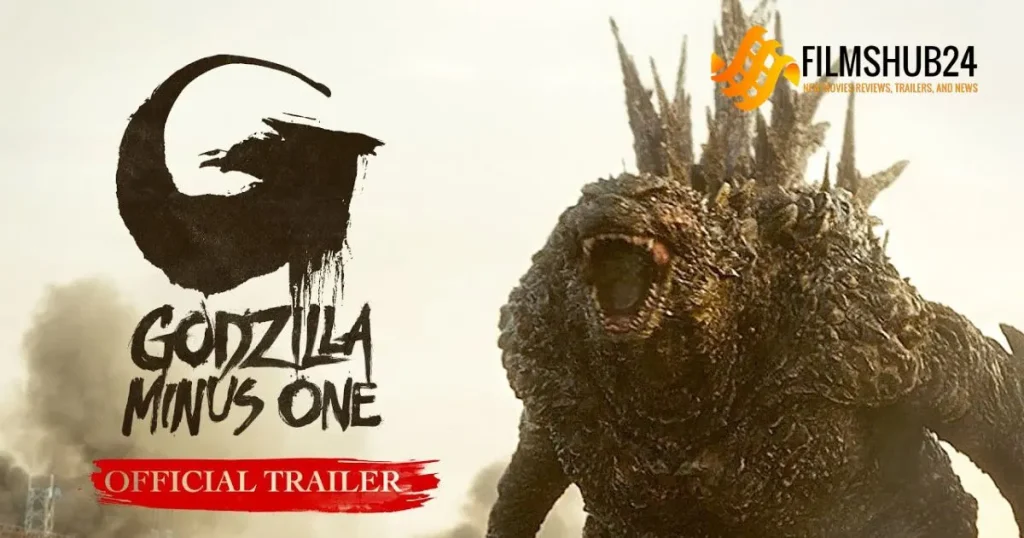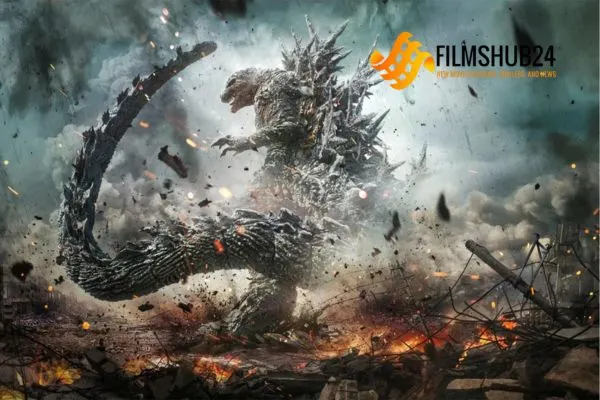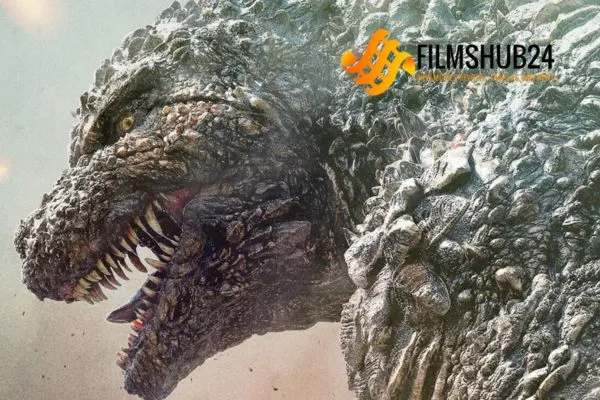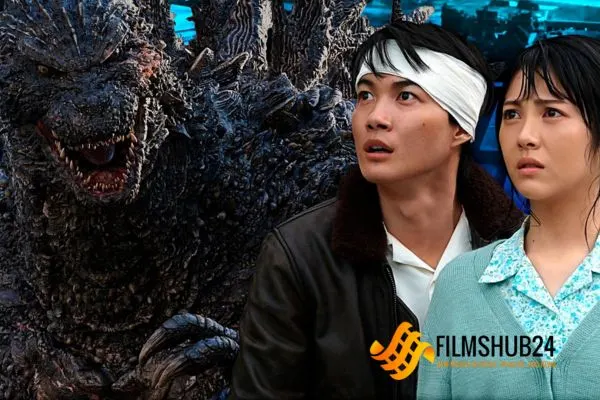
“Godzilla Minus One” (2023) revisits the origins of the iconic kaiju in spectacular form, combining traditional monster horror with a revisionist tale of post-war Japan. Directed by Takashi Yamazaki, Toho Studios’ latest interpretation of Godzilla returns the king of the monsters to his roots, giving us the vision of horror that was hidden behind so many sequels. following the landmark original 1954 film. This review on Filmshub24. com discusses “Godzilla Minus One” and how the film manages to reenvision this classic monster in ways that make it exhilarating for second-timers as well as those seeing Godzilla with fresh eyes.
Plot Overview
With a setting in the post-World War 2 era, Godzilla Minus One follows Japan struggling under the weight of war, unlike any other time when an event like Godzilla would not make sense. The whole population flees on foot with civilization under an even greater threat: Godzilla, a giant allegory of destruction born as a result of man’s aberration in the form of nuclear power. The movie brings in new faces, as well a band of survivors working to piece their lives together against the shattered landscape of Tokyo. The Protagonist: Koichi, a naval officer wrecked by guilt and trauma from the recent war, who is looking for redemption in the shadow of hopelessness.
The personal and societal are seamless in the plot, where Godzilla is depicted as both a mad man and a mirror onto the attempt of Japan to climb from its ashes. This is not a fight against some oversized monster — this is a fight against the specter of war, with Godzilla acting as the culmination of humanity’s worst nightmares. At base, it is an exciting, heartwrenching story of the struggle to survive in a world gone rotten and a paean to human willpower amid planetary s__t-hitting-the-fan.
Director Takashi Yamazaki: The Balance Of Horror/Warmth
Godzilla Minus One Directed by Takashi Yamazaki was a master class of direction. Yamazaki, who has made a name for blending human drama with large-scale VFX spectacle, bodes an interesting direction for the Godzilla genre in favor of a more emotional-driven devastation. This harkens back to the original 1954 film, looking at Godzilla as not just a giant creature but instead, a symbol of nuclear terror and human folly.
Yamazaki is great at creating tension and pacing so that the audience actually feels the weight of Godzilla being there. Rather than jumping headlong into the action, it gradually builds an atmosphere of menace, such that each kaiju appearance really does feel like something feared. Focusing on the human element, Yamazaki brings the people of Godzilla’s world into focus as much as the monster itself.
Mind Blowing VFX and Cinematography

The effects work (due to Toho regular Koichi Kawakita) in Godzilla Minus One is some of the best you’ll see in this era for a lighter-weight budget production. Details in Godzilla reflect this return to an older and imposing look, with numerous life-like textures used that help bring the creature to life/sell its menace. The destruction scenes are large and small — showcasing the sheer magnitude of Godzilla’s power while also zeroing in on the intimate, personal dramas unfolding in the impact zone.
The cinematography by Kōzō Shibasaki contrasts the desolate, war-torn landscapes of post-war Japan with the might and size of Godzilla. How lighting, shadow, and smoke is used in the movie makes you feel dread as Godzilla shows up the way a natural disaster would. Every point effectively demonstrates how perilously close the people of Skull Valley come to being outmatched by the supernatural forces threatening to make them its new inhabitance.
Strong Performances As The Heart Of The Film
The performances manage to take “Godzilla Minus One” out of the monster movie doldrums. Ryunosuke Kamiki is a standout as Koichi, the seafaring officer-turned-reluctant-savior. His depiction of guilt, terror and resolve bring layers to the story and turn him from simply another survivor into an emblem of mankind’s will.
Strong emotional beats are provided by a supporting cast that includes Minami Hamabe, Hidetaka Yoshioka, and several other key players. These human moments keep the movie grounded and humanize it, making you realize that Godzilla’s destruction has actual people with aspirations, motivations, and fears. It allows a greater focus on character development and this makes the stakes feel even higher and thus, more hard-hitting.
Nuclear Horror, Human Survival and Redemption.

Godzilla Minus One goes back to Godzilla’s origins as a symbol for nuclear disaster and humanity’s negligence. At the same time, the film delves into themes of loss, guilt and redemption — portraying a rounded picture of how both individuals and nations alike are forced to deal with the scars that history leaves behind. He’s also not simply a monster but rather an entity that forces people to confront their own mythologies and the monsters they keep inside.
It is this idea that the movie explores when it comes to starting from “minus one”, i.e. complete destruction, and building back up again. Beautifully illustrative of post-war Japan, this is a parallel path taken by the nation experiencing mistreatment and victory in the same way. In an unwavering portrayal of the grim reality of survival, The Host doesn’t hold back when it comes to the morality saga that accompanies it: rendering a truly human story against the starkiness of monster attacks.
Sound Design and Music: Upping the Ante on Tension The feature’s sound design was a major component in amplifying the unfolding drama. The monster’s roars send shivers down the spine, adding a primal level of fear into almost every shot. The sounds of destruction – crumbling buildings and echoing explosions – added another layer of immersion, projecting the audience right into the weight of each grim moment. Composer Naoki Sato used a combination of traditional orchestra and haunting background noises to bring the film’s emotional journey to life. Whenever the giant lizard is on the screen, one can hear the urgency and despair in the background.
During quieter times, however, the background tunes are nostalgic, underlining the devastating human cost of the horrific creature’s wrath. Critical Reception: A Welcome Return to Form for Toho The feature was received positively by critics and audiences alike as a successful return to the original concept—to a large degree due to Yamazaki’s treatment, the visual effects and exceptional storytelling. It was a strong statement about the appeal of Godzilla—to offer pulse-pounding action, yet always provide some food for thought.
Critics noted the mother’s return to the franchise was long overdue, and realized it with much success. The horror vibe and the roots of the franchise, which were clearly presented to a mainstream audience, were ranked as the best elements of the film—the horror from the perspective of Hideo Kura’s survivors and the roots of what Godzilla always represented. It was described as a monster movie that can be appreciated by everyone, even the non-fans. Thus far past monster movies, the film is a testament to the power of what a well-narrated story can be.

Conclusion
After over sixty years, “Godzilla Minus One” is an absolute cinematic slam-dunk — an edge-of-your-seat thrill ride with a heart that completely redefines what makes Godzilla so timeless on the big screen. The film — notable for Takashi Yamazaki’s flying-handling and what will likely become the Godzilla Cream eclipse as part of Larry Fong’s amazing Kongs: Double Deals — features one of the most potent entries in a franchise that enjoys enduring popularity. For fans of kaiju movies, or anyone who enjoys a story with human characters that has something to say about the indomitable nature of our spirit against seemingly insurmountable odds.
At Filmshub24. Here at FilmDoo.com, we love films that go out on a limb and tell an interesting story, which is exactly what Godzilla Minus One at filmshub24does. It’s a haunting, exhilarating, and ultimately uplifting film that puts Godzilla back in his proper spotlight–proving once again that the King of All Monsters is still movie magic.
